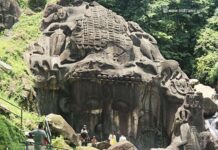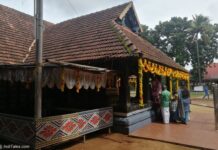For years I have dodged the question – which is my favorite temple?. How does one pick when one has visited and studied so many? Is one temple more important than the rest of temples? Do temples not have different roles at different points in time? All these questions bothered me, till I figured out that the temple closest to where you live is the best one for each of us. However, the question of what makes a temple perfect or worth emulating is a question that stayed with me for the longest time. Deep down, I was looking for this answer, without much success.

The answer came to me when I was spending a couple of months as a scholar in residence at Banaras Hindu University in Varanasi. That is Sri Vishwanath temple on the campus of BHU.
Sri Vishwanath Temple BHU Varanasi – A Model Temple
Now, Varanasi is full of temples, some known, some not so well known. You stumble upon small temples at every nook and corner, every step of the ghats as you walk around the oldest living city in the world. It is not within the confines of the city bound by Varuna and Assi rivers that I found my answer. I found it in the BHU campus itself. Yes, I am talking about the Vishwanath temple in the middle of the university campus and not the Kashi Vishwanath temple in Varanasi.
Walk to your nearest temple
For two months, I walked to this temple every morning from my guest house. Slowly, I started discovering the different elements like the smaller temples that surround the main Vishwanath temple, the temples on the first floor or the Nataraja temple on the side, the Yagnashalas and the plants around it.

The main temple is dedicated to Shiva as Vishwanath, represented through a large Linga along with Vedas. On either side of the temple are smaller temples of Hanuman ji and Ma Saraswati. One side of Vishwanath is Mata Parvati with Ganesha and on the other side is a Chaturmukhlinga.
On the first floor, you see another Shiva temple right on top of the ground floor one, surrounded by Mahamaya and Lakshmi Narayana on either side. Slowly, I started stopping in front of the rising Sun that illuminates the temple as it rises. It appears almost like a deity from the first floor. Behind the temple are trees like Amla that are worshipped too.
Knowedge on walls of the BHU Vishwanath Temple
The walls of the temple are full of small snippets and verses from Vedas, Upanishads, Puranas and words of saints like Swami Ramakrishna with pictures carved in marble panels. Scenes from scriptures are depicted on some panels. The whole of the Bhagawad Gita is inscribed on the back of the first floor temples. It became a ritual for me to read one sculpture and the words inscribed on it every day. It was like getting a task to think about an ancient wisdom nugget and see how it applies to our lives today. A good thought for the day, a slow Swadhyaya for those who visit the temple.

As I kept visiting the temple, the staff and the priests started recognizing me. On random days, they would ask me to do Jalabhishek or give me flowers from the linga. Someday, the shoe keeper would have a small chat. On Tuesdays, I would join the security staff in chanting the Hanuman Chalisa. Some days, I would sit and soak in the divinity all around.
Meditation, Pranayama and Yoga
In the lawns of the temple, on benches and small canopied sit-outs, I would see people doing meditation, pranayama and yoga. In the Yagnashala, a group of senior citizens would be chanting stotras or singing bhajans. Students of the visual arts display their art for those who may want to buy it. Soothing devotional music plays in the mornings, which would be perfect if the students of music were singing live. Inside the temple, I observed a young man doing Durga Saptashati Path in front of the Mahamaya temple on the first floor.

On the day of convocation, it is a delight to see the students coming with their degrees in ceremonial dresses to offer them at the feet of Shiva. To me, this is a huge marker of how the temple becomes an integral part of everyone who gets to live in the BHU campus or its vicinity. Most students and visiting scholars like me come and stay in the vicinity for a short period of time, but because the temple is so well integrated into the life of BHU, you naturally get attracted to it and make it a part of your daily routine.
Visits
The temple is well-visited throughout the day. Early morning, you see the morning walkers stopping by, in the evening and on holidays, it is full of tourists and pilgrims. Then there are students who come for a cold coffee or a freshly made samosa chaat. Chai, like elsewhere in Kashi, is never too far. My personal favorites are the two bookshops and souvenir shops that are on either side as you enter the temple. In the morning, it is calm and serene with only flowers and Prasad shops open, but in the evening, the area is pulsating with energy, with eateries being more in focus. All this is a part of the temple, but still outside its main entrance.

The temple was conceptualized by Madan Mohan Malaviya ji as an integral part of the BHU Campus. His Murti, looking at the temple, is the first thing you notice when you reach the temple. You would also see many students and staff of BHU bowing down to him before proceeding to the temple. It was built by the Birla family between 1931-1966 CE. Popularly called VT, it is also called Birla Mandir, and you do see a resemblance with the rest of the Birla temples across the country. At 250 feet, this temple has the tallest Shikhara among all the Hindu temples, past and present. People in the university remember this fact as the temple being taller than the Qutub Minar.
Visit the Vishwanath Temple Next Time in Varanasi
Do visit the Vishwanath Temple as and when you visit Kashi. You can take a few lessons that you can apply to your neighborhood temple. See how the temple provides space for everyone to be a part of the temple and yet understand that it belongs to everyone else as much as it belongs to me. The cleanliness and the walkability allow people to move around even when there are a lot of people. Yes, it is a fairly big temple, while our own neighborhood temples may be very small in comparison, but the number of people visiting them on a regular basis would also be small. See if you can make a cultural space along with being the spiritual one, where young and old can visit with equal ease.
Sri Vishwanath temple at BHU Varanasi comes closest to my imagination of how a temple should be in our times. A space for people to have one-on-one conversations with the devatas, as well as a place for us to interact with those who live within the precincts of the temple and those visiting it from distant places.














I liked your content very much. I went to Chardham Yatra by helicopter, and I must say it was the best adventure of my lifetime, the Char Dham Yatra was smooth and so comfortable. I insist everyone must visit chardham, It will be spiritual and adventurous, watching Himalayas up close will become your best memory!
Such a peaceful and divine place! Temples like these truly connect us to our roots. Thanks for sharing this spiritual gem!
Excellent posting.. Keep writing more.. Wishing you all the success
This is a wonderful overview of the Kashi Vishwanath Temple, one of the most sacred Hindu sites. The rich history of repeated destruction and reconstruction shows the resilience of devotion here. The spiritual significance as a Jyotirlinga and the connection to the Ganges River make it a powerful pilgrimage destination. Thanks for sharing the cultural and religious importance of this timeless temple